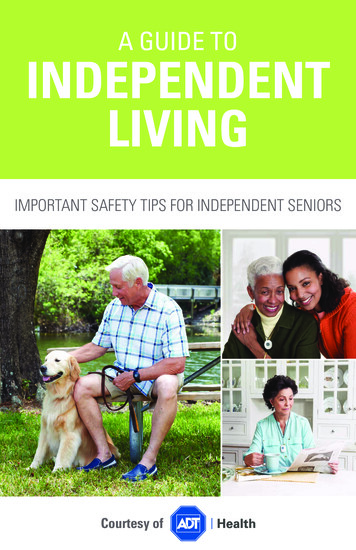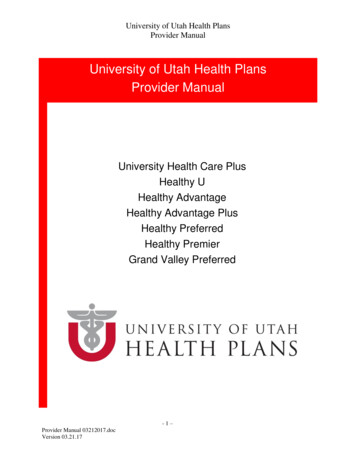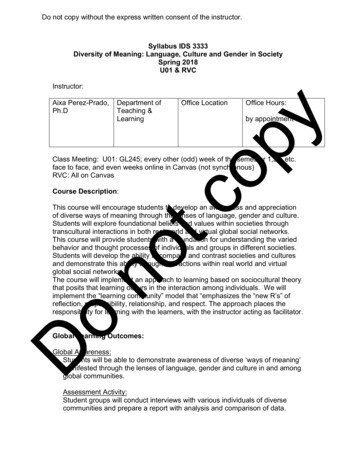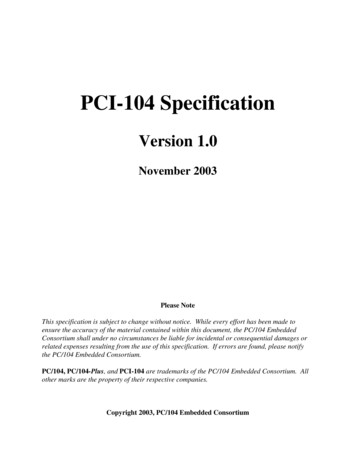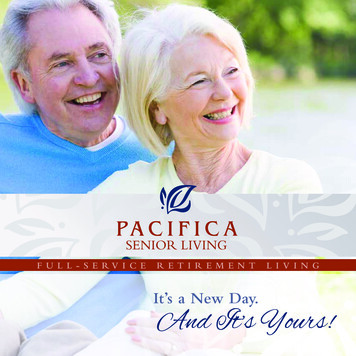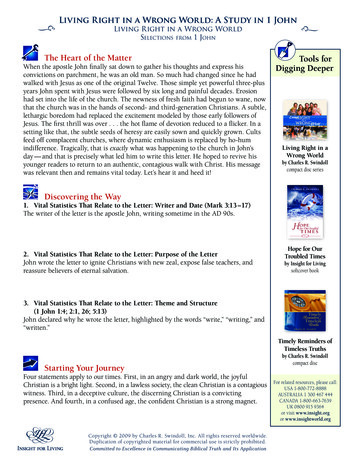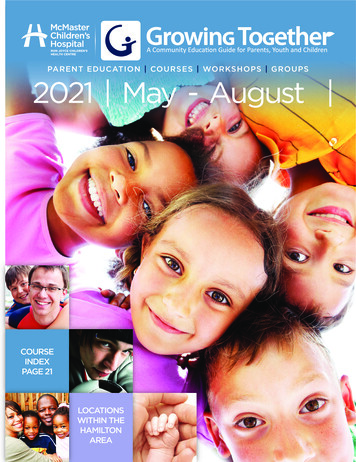
Transcription
ENAFS Healthy Living ProgramModule: Small Steps for Health and WealthLesson 7: Staying Awake: Be Engaged! Be Active!Be Aware!Topics to be CoveredWhat’s InsideBackground1Health Strategies2Wealth Strategies5Take Home Message6Optional Activities6References7Materials Needed PowerPointPresentation“StayingAwake!” (Included) Computer andProjector (foroptional PowerPointPresentation)“Older, we must move, and stay, and move again, to keep our lifegiving ties alive, for this movement is our fountain of age. And there’sa freedom in realizing this, a new freedom to move or stay, newnecessities and possibilities of choice.” – Betty FriedanHealth StrategiesWealth StrategiesBe Engaged in Your Life Be Active in Your Health Preventive Health Health Milestones Financial MilestonesObjectivesLearning ObjectivesBehavioral Objectives Participants will learn the importance of being active in theirhealth including health milestones by age. Participants will be a more active participant in their healthand be able to identify healthmilestones by age. Participants will learn important financial milestones byage. Participants will be able toidentify financial milestones byage.Background InformationYou are never too old to remain active in your life. Too often, inactivity isthe cause of many negative thoughts and outcomes (such as poor health orfinancial problems). You can take small steps to be more active physicallyand fiscally. The more active you are, the healthier you will likely feel andthe more aware you will be of your finances! When your physical, emotional,financial, and social health is in order you can be an active participant inyour life and enjoy life to its fullest. None of us are sure how much time wehave left – might as well enjoy every minute we can! You can embrace lifeand live it to its fullest, enjoy every waking minute, and live within yourboundaries.
Module 10: Small Steps to Health and WealthTM for Older AdultsHealth StrategiesBE ENGAGED IN YOUR LIFE!There are little things we can do, small steps we can take to make sure that we are living life to its fullest and healthiest.Invigorate your life! When you feel rejuvenated and energized you are excited about life and get to experience wonderfulthings! When your body and mind are aware and stimulated, you can live life to the fullest. Staying awake and energized is the way to enjoy your life! Many people as they get older spendmore time sleeping, relaxed, depressed, and lethargic. Although sleep is very important, when youare awake – stay awake! Be involved in something you love! Be an active participant in your life. Every week we can: do our favorite hobby, read a book or magazine, watch a good movie, visit thepark, volunteer, do something we love, have dinner with our loved ones, cook a healthy meal,stretch our bodies, visit close friends and family members, be appreciative, and value our strengths.BE ACTIVE IN YOUR HEALTH!Take small steps to step up your health When you are starting to become more physically active, it can seem to take a lot of time and energy. But once you are active and get into a routine that works for you, it can become fun and enjoyable! Just because our bodies may stop us from running a marathon, does not mean that we can’t take awalk around the park, the neighborhood, or even to our back yard and feel great about it! Knowyour limits but be able to enjoy what you can do within your boundaries. Each and every day we can: wash our hands, buckle up, protect our skin, read food labels, check ourbody for lumps and sores, eat healthy, take a break, take a nap, ask questions, go for a walk, call afriend, write a letter, and tell someone you love them (CDC, 2012).PREVENTIVE HEALTH VISIT EACH YEAR SHOULD INCLUDE: Checking height and weight Checking body mass index (BMI) Screening for alcohol and tobacco use Screening for depression Screening for the risk of falls Discussing medication interactions Screening for hearing lossUF/IFAS ExtensionPage 2
Module 10: Small Steps to Health and WealthTM for Older AdultsHealth Strategies (continued)In addition to your preventive health care annual visit, there are other specific times when you shouldsee your health care provider. This is only provided for information purposes and you should consultyour health care provider. General, age-specific health screening guidelines are as follows:Health Milestones: Screening – Over Age 65 (MedLine Plus, 2013)Blood pressure screening: Have your blood pressure checked every year. If you have diabetes, heart disease, kidney problems, or certain other conditions, you may need tobe watched more closely.Cholesterol screening: If your cholesterol level is normal, have it rechecked every 5 years. If you have diabetes, heart disease, kidney problems, or certain other conditions, you may need tobe monitored more closely.Dental exam: Go to the dentist every year for an exam and cleaning.Eye exam: Have an eye exam every 2 years, make sure your health care provider checks for glaucoma.Immunizations: If you are over 65, get a pneumococcal vaccine if you have never had before, or if you received onemore than 5 years before you turned 65. Get a flu shot every year. Get a tetanus-diphtheria booster every 10 years. Get a Tdap vaccine if you have not had one. You may get a shingles or herpes zoster vaccination once after age 60. You can get it at any age ifyou never had the vaccination.Health Milestones: Screening – Men - Over Age 65 (MedLine Plus, 2013)Abdominal aortic aneurysm screening: Men between ages 65 - 75 who have smoked should have an ultrasound Other men should discuss such screening with their health care providerColon cancer screening for men age 50 - 75: One of the following screening tests should be done: A stool test every year Flexible sigmoidoscopy every 5 years along with a stool occult blood test Colonoscopy every 10 years After age 75, you should discuss colon cancer screening with your doctor You may need screening earlier or more often if you have risk factors or a family history ofcolorectal cancerOsteoporosis screening: All men over age 65 should discuss osteoporosis screening with their health care provider.Prostate cancer screening: All men should discuss prostate cancer screening with their health care provider. During screening a PSA test is done.UF/IFAS ExtensionPage 3
Module 10: Small Steps to Health and WealthTM for Older AdultsHealth Strategies (continued)Health Milestones: Screening – Women - Over Age 65 (MedLine Plus, 2013)Colon cancer screening: Until age 75, one of the following screening tests should be done: Virtual colonoscopy (computed tomographic colonography) every 5 years A stool test every year Flexible sigmoidoscopy every 5 years along with a stool guaiac test Colonoscopy every 10 years Patients with risk factors for colon cancer, including ulcerative colitis, a personal or family history ofcolorectal cancer, or a history of large colorectal adenomas may need a colonoscopy more often.Diabetes screening: If your blood pressure is above 135/80, your health care provider will test your blood sugar levels fordiabetes.Breast exams: Women may do a monthly breast self-exam, contact your doctor or nurse immediately if you noticea change in your breasts. A health care provider should do a complete breast exam every year.Mammograms: Women should have a mammogram done every 1-2 years, depending on their risk factors.Osteoporosis screening: All women should have a bone density test (DEXA scan). Ask your doctor or nurse about how much calcium you need and what exercises can help preventosteoporosis.Pelvic exam and Pap smear: After age 65, most women can stop having Pap smears as long as they have had three negative testswithin the past 10 years.UF/IFAS ExtensionPage 4
Module 10: Small Steps to Health and WealthTM for Older AdultsWealth StrategiesBE AWARE OF YOUR FINANCIAL MILESTONES!Confused about the ages when certain financial actions can, or need to, be taken? If so, you are notalone. Read the list below to learn about age-related financial milestones that occur in later life. Manyof these milestones provide new opportunities (e.g., the ability to save more money for retirement or toclaim Social Security and Medicare benefits) and new legal requirements (e.g., the mandatory distribution required from tax-deferred retirement savings plans). Milestone events are listed chronologicallyby age.Milestone Age50Description of Milestone Event 55 Eligibility for retirement savings plan catch-up contributions (up to 5,500 for taxdeferred employer plans such as 401(k)s and 403(b)s and 1,000 for IRAs in 2013)Eligibility for Social Security survivor’s retirement benefits by disabled widowsand widowersEligibility to join AARP, which provides access to product and travel discountsEligibility for penalty-free employer retirement savings plan withdrawals if youleave a job (taxes, of course, would be owed and this provision does not apply totraditional IRAs)Eligibility for “senior discounts” from many stores, restaurants, and other businesses55 to 60 Eligibility to retire from many public sector pension plans with 25 to 30 years ofservice59 ½ Eligibility to make withdrawals from a traditional IRA and/or tax deferred employer plan without paying the 10% penalty60 Eligibility for Social Security survivor’s benefits by widows and widowers (unlessdisabled)62 Eligibility to claim a reduced (20% to 30%, depending on age) Social Security benefitEligibility to apply for a reverse mortgage62 to Full RetirementAge (FRA) Time span (depending upon year of birth) that the Social Security earnings limitapplies (beneficiaries will lose 1 in benefits for every 2 over the annual threshold amount)63 ½ Age to claim COBRA benefits for 18 months prior to eligibility for Medicare (ifqualified)65Eligibility to claim Medicare benefits65 to 67 70 Maximum age for eligibility to receive Social Security delayed retirement credits(8% per year for those born in 1943 or later)70 ½ Age at which mandatory withdrawals from retirement savings accounts (exceptRoth IRAs) must beginFull retirement age (depending upon year of birth) for eligibility for a full(unreduced) Social Security retirement benefitAdapted from: Financial Fitness for the Rest of Your Life: What Older Adults Need to Know about Money.UF/IFAS ExtensionPage 5
Module 10: Small Steps to Health and WealthTM for Older AdultsTake Home MessageYou can be happier and healthierphysically and fiscally by beingengaged, active, and aware.Optional ActivitiesYOU WILL NEED Test Your Aging Knowledge HandoutDISCUSSION PROMPTS INSTRUCTIONSDiscuss the quiz answers and aging misconceptions.1. Distribute handouts to participants2. Ask participants to complete the quiz.HandoutsWoolf, L. Aging Quiz. Retrieved icket roBGrQD%2BFOA%3D&tabid 1174UF/IFAS ExtensionPage 6
Module 10: Small Steps to Health and WealthTM for Older AdultsReferencesCenter for Disease Control and Prevention. (2012). Five minutes (or less) for health. Retrieved from:http://www.cdc.gov/family/minutes/#.Financial Fitness for the Rest of Your Life: What Older Adults Need to Know about Money. Retrievedfrom y-advice.pdfMedline Plus. (2013). Health Screening—Men—Over Age 65. Retrieved e/007466.htmMedline Plus. (2013). Health Screening—Women—Over Age 65. Retrieved e/007463.htmWoolf, L. Aging Quiz. Retrieved icket roBGrQD%2BFOA%3D&tabid 1174Lesson Authors:Martie Gillen, Ph.D., MBA, Assistant Professor and Family andENAFS Healthy Living ProgramModule 10: Small Steps to Health andWealthTM for Older AdultsLesson 1: Living Well on a ShoestringLesson 2: Understanding LabelsLesson 3: Your Frames of ReferenceLesson 4: Stretching Your Body and YourMindLesson 5: Avoiding Fraud and ScamsLesson 6: Taking the Driver’s SeatLesson 7: Staying Awake: Be Active! BeEngaged! Be Aware!Consumer Economics for Older Adults Specialist, Family, Youthand Community Sciences, IFAS/Extension, University of Florida.Amanda Terminello, BS, Graduate Student, Family, Youth andCommunity Sciences, IFAS/Extension, University of Florida.Lesson Reviewers:Barbara O’Neill, Ph.D., CFP, Professor II and Extension Specialistin Financial Resource Management, Rutgers CooperativeExtension.Karen Ensle, Ed.D., RD, Family and Community Health SciencesWe’re on the Web!Educator. Rutgers Cooperative Extension.http://fycs.ifas.ufl.edu/enafsUF/IFAS ExtensionPage 7
Test Your Aging KnowledgeTrue or False1. The majority (more than 50%) of older adults will become senile (defectivememory, disoriented, demented) during old age.2. Chronological age is the most important determinant of age.3. Declines in all five senses normally occur in old age.4. Physical strength tends to decline in old age.5. Intelligence tends to decline with old age.6. The majority of older adults say that they are happy most of the time.7. The majority of older adults say that they are lonely.8. Pain is a natural part of the aging process.9. The majority of older adults say that they feel irritated or angry much of the time.10. Rarely does someone over the age of 65 produce a great work of art, science, orscholarship.Adapted from: Woolf, L. Aging Quiz. Retrieved icket roBGrQD%2BFOA%3D&tabid 1174
Test Your Aging KnowledgeAnswers1. The majority (more than 50%) of older adults will become senile (defective memory,disoriented, demented) during old age.Answer: False - Contrary to popular stereotype, dementia is not a normal part of aging orinevitable. Statistics will vary depending on the study, but most estimate that approximately 2-3percent of older adults in their seventies experience some form of dementia, 5-10 percent ofolder adults in their eighties, and may jump to between 20-30 percent of older adults in thenineties. These statistics include mild as well as severe forms of dementia. Research concerningnot only the treatment but prevention of dementia is ongoing and promising.2. Chronological age is the most important determinant of age.Answer: False - Individuals age in many different ways and the least important of those ischronological age. Chronological age is simply the number of years since one's birth. Moreimportant is functional age--how well one is able to function in their social environment. Threefactors that make up functional age are psychological age, social age, andphysiological/biological age. We have all met individuals who biologically are nearing the end oftheir life span but psychosocially are independent, creative, vibrant, and well able to meet life'schallenges.3. Declines in all five senses normally occur in old age.Answer: Mostly True - For the most part, all five senses decline in old age for individuals livingin the United States. Some normal age declines are viewed cross-culturally and clearlydocumented (e.g. the changes that occur in the visual system with age). There are numerouschanges that occur with vision that are highly correlated with age. However, the dramaticdeclines that are recorded to occur in the auditory system may be due more to the cumulativeeffects of noise than to age. Most individuals living in low-noise cultures (e.g. nomadic cultures,simple agrarian cultures) do not exhibit a loss of hearing with age. Use your iPod carefully withan eye towards how much you want to hear in old age.4. Physical strength tends to decline in old age.Answer: True - Physical strength does tend to decline with age. Of course, exercise cancounteract and limit the amount of loss. Thus, someone who is 65 and exercises regularly may be(probably will be) in better shape and have greater physical strength that a 40 year-old couchpotato.
5. Intelligence tends to decline with old age.Answer: Mostly False - Most older adults do not experience any decline in intellectual abilitieswith age. In fact, some forms of intelligence have been hypothesized to increase with age.However, some older adults do exhibit decline. There are several factors which may account forthis decline. First, some diseases may lead to intellectual declines (e.g. cardiovascular diseases).Thus, the intellectual decline is the result of disease not age. Second, individuals who live indeprived environments demonstrate a loss of intellectual abilities (e.g. poverty, lack ofintellectual stimulation). Of course, problems such as impoverished environments impact theintellectual performance of children as well. Third, if you do not use it, you lose it. Exercise anyintellectual ability that you would like to keep!6. The majority of older adults say that they are happy most of the time.Answer: True - The majority of older adults report high levels of life satisfaction. The moresocially active an individual is, the higher their life satisfaction. Thus, the importance ofremaining involved in informal, intimate activities.In addition, health is correlated with life satisfaction. Individuals, of any age, who are in poorhealth are likely to experience lower levels of life satisfaction. Not only will exercise and eatinga healthy diet facilitate long life but also a good quality of life.7. The majority of older adults say that they are lonely.Answer: False - Loneliness is one of the greatest fears that people associate with old age. Yet,over two-thirds of older adults report being rarely or if ever lonely. This parallels the degree ofloneliness experienced by young and middle adults.Often, this fear of loneliness is based on the thought of losing a spouse and subsequent isolation.This fear is not based on reality for most individuals. The majority of men remarry after the lossof a spouse. Women, however, are more likely to become involved in new social relationshipsand friendships with other widows.Research has also demonstrated that urban living is associated with higher levels of loneliness.Individuals within small-towns report lower levels of loneliness.8. Pain is a natural part of the aging process.Answer: False - Pain is not a natural part of the aging process. Rather it is a sign of injury orillness. As such, pain should not be ignored. Unfortunately, too often people will attribute paintoo aging and wait too long to seek medical help with negative outcomes.A man goes to the doctor complaining of pain in his right knee. The doctor says to him, “Youhave to expect this. You are getting older". To which the man replies, "My other knee is just asold and it doesn't hurt." It is true that some individuals will experience more pain as they age butthis in the result of the accumulation of injury or illnesses. Thus, the pain is again due toinjury/illness and not age.
9. The majority of older adults say that they feel irritated or angry much of the time.Answer: False - Older adults are no more angry or irritated than younger adults. Individuals whoare angry or irritated a good portion of the time while younger will probably be individuals whoare angry or irritated a good portion of the time in old age.10. Rarely does someone over the age of 65 produce a great work of art, science, orscholarship.Answer: False - The creative and scholarly work of older adults is truly amazing. One study,demonstrated that the sixties (age not decade) are the most productive years for historians,botanists, inventors, philosophers, and writers. Whether it is Goethe finishing Faust at 82,Michelangelo finishing the dome of St. Peter's or Cervantes writing Don Quixote in old age, theevidence for great works after 65 is clearly apparent. I. F. Stone authored of The Trial ofSocrates while in his eighties. In his acknowledgements, he wrote, “Finally, I pour a libation tomy Macintosh word processor. Its large fat black 24-point Chicago Bold type enabled me toovercome a cataract and write the book." - thus, shattering many of the myths concerning aging.
Lesson 7 – Staying Awake: Be Engaged! Be Active! Be Aware!Leader’s Guide Class Outline – 30 minutesTimeActivity/TopicMaterials2 min.00:00-00:03Quote: Use the quote as an icebreaker. Read the quote.Introduction: Introduce the topicSlides 1-28 min.00:03-00:07Health strategiesBe engaged in your life, be an active participant in your health,preventive health care, health milestones screening over age 65,health milestones men - screening over age 65, and healthmilestones women- screening over age 65Wealth strategiesFinancial milestones age 50, financial milestones age 55, financialmilestones age 55 to 60, financial milestones age 59 ½, financialmilestones age 60, financial milestones age 62, financialmilestones age 62 to FRA, financial milestones age 63 ½,financial milestones age 65, financial milestones age 65 to 70,financial milestones age 70, and financial milestones age 70 ½Take home messageSlides 3-95 min.00:19-00:27ActivitiesTest Your Aging Knowledge HandoutSlide 243 min00:27-00:30Questions: Answer any remaining questionsSlide 2511 min.00:07-00:181 min.00:18-00:19Slides 10-22Slide 23
EVALUATIONThank you for being a part of this lesson. We hope you enjoyed yourself!Please help us do a better job of serving you by completing this evaluation.1. How much did you learn from this lesson? Please check only one: Very little Some A lot2. Do you plan on making changes as a result of participating in this lesson? Yes No3. If you answered “yes,” please tell us what you plan to do. Check all thatapply! I plan to use one of the strategies from this lesson to change a healthrelated behavior. I plan to I plan to use one of the strategies from this lesson to change a personalfinance behavior. I plan to I plan to share information I learned today with a family member orfriend.4. Comments:Thank you for completing this form! We look forward to seeing you at ourother ENAFS programs!ENAFS Healthy Living ProgramModule 10: Small Steps to Health and Wealth for Older AdultsLesson 7: Staying Awake
Module: Small Steps for Health and Wealth Background 1 Health Strategies 2 Wealth Strategies 5 Take Home Message 6 Optional Activities 6 References 7 What’s Inside Background Information the cause of many negative thoughts and outcomes (such as poor health or financial problems). You can take
